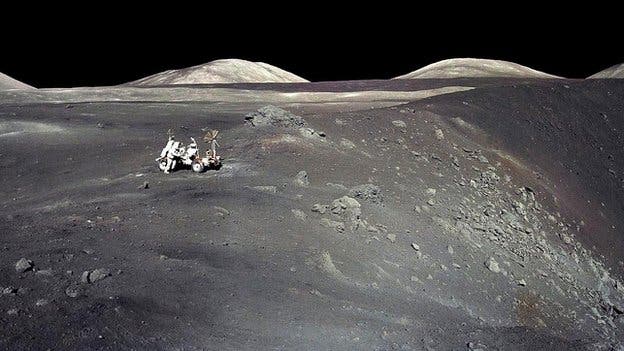
An eminent team of US researchers found that it is highly unlikely that the moon ever once harbored important quantities of water, after studying a mineral called apatite. Generally speaking, scientists have always though the moon was water barren, a theory confirmed by the initial rock samples brought back by the Apollo missions, however in the past decades or so new modern mineral analysis suggested that Earth’s satellite is much wetter than some believe.
Now, a new set of findings reported by a team of researchers from the US, some of whom supported the wet moon theory in the past, suggests that the high hydrogen content from volcanic glasses and apatite in lunar rocks results from a more complex chemical process, one that doesn’t fits a wet moon scenario. Conveniently enough, the name apatite comes from the Greek word ‘apat’, meaning ‘deceit’.
Lead author Dr. Jeremy Boyce, a Nasa Early Career Fellow at the University of California, Los Angeles, along with his distinguished colleagues, simulated the formation of apatite minerals containing different amounts of volatile elements – hydrogen, chlorine and fluorine.
The simulation demonstrated that you could start off with any kind of water composition in the magma, yet still end up with the same apatite configuration simply by varying the chlorine content and degree of crystallization. The findings suggest that the mineral’s structure formation is not as simple as saying the more hydrogen in the apatite, the more there was in the magma. Instead, it all boils down to competition between elements .
Apatite wants to pair up with fluorine, since its electron configuration is the most stable to join with. Then comes chlorine, and right at the end when there isn’t much left, hydrogen.
“So all the apatites are taking all the fluorine and hiding it from the melt. Then the melt forgets that it had all that fluorine and the apatites get more chlorine-rich and more hydrogen-rich,” the researchers write.
Back where we started: a dry moon
It’s because of this that the original indication that claimed the moon may once have been abundant in water could be false. Moreover, a lot of water on the moon contradicts the current prevailing theory concerning its formation. The theory goes that during our solar system’s infancy, a giant planetary body called Theia collided with Earth, blasting rock into Earth orbit. These debris coalesced to eventually form the moon, but in the process volatile materials must have been boiled off, leaving little water on the moon relative to Earth. So a less watery Moon ties in better with this theory.
Not only this, there are potentially other sources of hydrogen on the moon like the solar wind.
“There is some hydrogen that’s coming in from the solar wind and getting stuck on the surface. But there is some amount – definitely seems to be less than on Earth – that the Moon started with,” said Dr Francis McCubbin, senior research scientist at the University of New Mexico.
If anything, scientists may be back to drawing board as these latest findings create new uncertainty as to how much water there used to be on the moon.
“Clearly, we did the best we could at the time. But that’s the progress of science – there are course corrections,” Dr Boyce explained.
“Definitely, there is still water on the Moon. Those rocks are not completely anhydrous. There’s a really interesting record of heavy chlorine and hydrogen isotopes. But the abundances, we’ve demonstrated, are difficult to interpret.”
Dr McCubbin commented: “Forty years ago, the Apollo astronauts built a building and the elevator was on a floor where [the water abundance] was one part per billion (ppb).
“We took it up to where we were near terrestrial abundances, and then we realised we were on the wrong floor. We’ve taken it back down, but not all the way down to where we were 40 years ago.”
The findings were reported in the journal Science.
Was this helpful?



